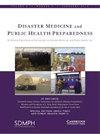应对生物事故的避难医院设计标准:系统回顾
IF 1.9
4区 医学
Q3 PUBLIC, ENVIRONMENTAL & OCCUPATIONAL HEALTH
引用次数: 0
摘要
背景 要妥善应对大规模生物事件,就必须做好充分准备,并提供快速增援能力。在这种情况下,将大型公共场所改造成避难医院是一个切实可行的解决方案。由于缺乏将大型公共中心改造成医院的指南,本研究收集了在应对流行病或大规模生物事故等生物事件时将公共建筑改造成避难医院的设计标准。方法 截至 2021 年 11 月,在 Scopus、Web of Science 和 PubMed 数据库中对关键词进行了检索。本系统综述使用了与大规模生物事故、避难医院和设计标准相关的术语。结果 在提取的 1802 篇文章中,初步评估剔除了重复文章(n = 280)和无关文章(n = 1342)。在剩下的 180 篇论文中,有 29 篇在审阅摘要和全文后符合我们的标准。纳入的大多数研究都与为应对 2019 年冠状病毒病(COVID-19)大流行而将公共场所改造成医院有关。调查的主题包括选址、布局和结构、废物和废水管理、通风、通信、食品和药品供应、人道主义者和社会支持、治疗后护理以及管理措施。结论 总之,在应对大规模生物事故时,大型公共场馆是非常值得推荐的增援能力选择。然而,使用这些中心所面临的主要挑战是提供水电、通风和可用空间等基本要求。本文章由计算机程序翻译,如有差异,请以英文原文为准。
Design Criteria of Shelter Hospitals in Response to Biological Accidents: A Systematic Review
Background The appropriate response to mass causality biological events requires well-established preparedness and providing a surge capacity. In such a situation, a practical solution is to convert large public venues into shelter hospitals. Due to the lack of a guideline for the transformation of a large public center into a hospital, the present study collected the design criteria for the transformation of public buildings into shelter hospitals in response to biological events such as epidemics or mass causality biological accidents. Methods The keywords were searched in Scopus, Web of Science, and PubMed databases until November 2021. This systematic review was conducted using terms related to mass causality biological accidents, shelter hospitals, and design criteria. Results Of 1802 extracted articles, duplicates (n = 280) and unrelated publications (n = 1342) were left out in the initial evaluation. Among 180 remained papers, 29 records satisfied our criteria after reviewing abstracts and full texts. Most of the included studies were related to the transformation of public venues into hospitals in response to the coronavirus disease 2019 (COVID-19) pandemic. The investigated themes included site selection, layout and structure, waste and wastewater management, ventilation, communication, food and medicine delivery, humanitarians and social supports, post-treatment care, and Management measures. Conclusions In summary, large public venues are highly recommended alternatives for surge capacity in response to mass causality biological accidents. However, the main challenges for using these centers are the provision of basic requirements such as water and electricity, ventilation, and available space.
求助全文
通过发布文献求助,成功后即可免费获取论文全文。
去求助
来源期刊

Disaster Medicine and Public Health Preparedness
PUBLIC, ENVIRONMENTAL & OCCUPATIONAL HEALTH-
CiteScore
4.40
自引率
7.40%
发文量
258
审稿时长
6-12 weeks
期刊介绍:
Disaster Medicine and Public Health Preparedness is the first comprehensive and authoritative journal emphasizing public health preparedness and disaster response for all health care and public health professionals globally. The journal seeks to translate science into practice and integrate medical and public health perspectives. With the events of September 11, the subsequent anthrax attacks, the tsunami in Indonesia, hurricane Katrina, SARS and the H1N1 Influenza Pandemic, all health care and public health professionals must be prepared to respond to emergency situations. In support of these pressing public health needs, Disaster Medicine and Public Health Preparedness is committed to the medical and public health communities who are the stewards of the health and security of citizens worldwide.
 求助内容:
求助内容: 应助结果提醒方式:
应助结果提醒方式:


